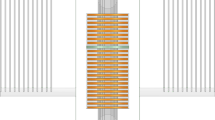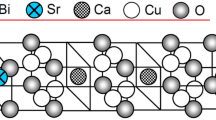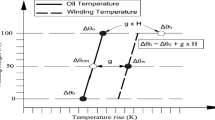Abstract
Thermal condition monitoring of distribution transformers (DTs) as the most important and expensive equipment of the power grid is undeniable, and by accurate investigation of its thermal status, its failure can be prevented because the insulation condition of the transformer is directly related to the hotspot temperature (HST). In this paper, accurate and nonuniform magnetic-thermal analysis of DT is proposed for precise HST prediction. In the magnetic analysis, the DT is modeled as a 2D axial symmetry, and the losses calculation of the windings has been fulfilled as a nonuniform. In the thermal analysis, the DT is modeled as 3D and nonuniform, and the conservator and core stacking, which has a considerable effect on the HST, is precisely modeled. By taking advantage of optical fiber sensors (OFSs) in the understudied 500 kVA DT, the accuracy of the proposed nonuniform 3D CFD-based modeling during the temperature rise test (TRT) is validated. The empirical evaluation results depict that the presented nonuniform CFD-based thermal analysis for HST prediction is very precise, and there is an appropriate vicinity to the experimental values. The error percentage of the proposed 3D CFD-based thermal analysis is 0.11% (0.1 °C) compared to the OFSs measurements, which demonstrates the precision and effectiveness of the presented modeling. Also, the verification of the results of nonuniform 3D CFD-based thermal analysis in top-oil temperature (TOT) and bottom-oil temperature (BOT) during the experimental TRT is fulfilled via thermography. According to the attained evaluated results, temperatures of 3D CFD-based thermal analysis and thermography in the noted two points are in good accordance with each other. In short, the error percentage is less than 0.65%, which indicates the correctness and proper performance of the proposed nonuniform 3D CFD-based modeling. Finally, the proposed nonuniform 3D model was subjected to voltage imbalance of 0.95, 1.05, 1.1, 1.15, and 1.2 of rated voltage. The results demonstrate the HST increases by − 0.4, 0.4, 0.9, 1.3, and 1.8 °C, respectively, over the original model without voltage imbalance, which represents that this issue should be considered in the design and operation of the DT.





























Similar content being viewed by others
Abbreviations
- A :
-
Area [\({\mathrm{m}}^{2}\)]
- \({c}_{p}\) :
-
Specific heat capacity \([\mathrm{J}/(\mathrm{ kg}\,\mathrm{ K})]\)
- D :
-
Diameter [\(\mathrm{m}\)]
- H :
-
Height [\(\mathrm{m}\)]
- h :
-
Heat transfer coefficient [\(\mathrm{W}/ {(\mathrm{m}}^{2} \,\mathrm{K})\)]
- HST:
-
Hotspot temperature [°C]
- k :
-
Thermal conductivity \([\mathrm{W}/ (\mathrm{m}\,\mathrm{ K})]\)
- L :
-
Length [\(\mathrm{m}\)]
- LCI:
-
Loading capacity increment (rated load + increment load) [kW]
- m :
-
Mass [\(\mathrm{kg}\)]
- Nu:
-
Nusselt number
- P :
-
Losses [\(\mathrm{W}\)]
- Pr :
-
Prandtl Number
- Ra:
-
Rayleigh number
- T :
-
Temperature [K], [°C]
- Th:
-
Thickness [\(\mathrm{m}\)]
- w :
-
Winding
- W :
-
Width \(\mathrm{m}\)
- \(\varnothing\) :
-
Volumetric concentrations percentage (%)
- \(\alpha\) :
-
Thermal diffusivity \({[{{\mathrm{m}}^{2}\,\mathrm{s}}^{ }]}\)
- \(\beta\) :
-
Thermal expansion coefficient \([1/ \mathrm{K}]\)
- ε :
-
Emissivity
- \(\upsilon\) :
-
Kinematic viscosity \({[{{\mathrm{m}}^{2}\,\mathrm{s}}^{ }]}\)
- \(\rho\) :
-
Density \([\mathrm{kg }/{\mathrm{m}}^{3}]\)
- \(\mu\) :
-
Dynamic viscosity \({[{\mathrm{Pa}\,\mathrm{s}}^{ }]}\)
- σ :
-
Stefan–Boltzmann constant \([\mathrm{W}/ ({\mathrm{m}}^{2} \,{\mathrm{K}}^{4})]\)
- a:
-
Ambient
- Cons:
-
Conservator
- cov:
-
Convection
- Fin:
-
Corrugated wall
- loading:
-
Windings + additional
- no-load:
-
Core
- o:
-
Oil
- rad:
-
Radiation
- s:
-
Surface
References
IEC 60076–7 (2018) Power transformers: Part 7: Loading guide for mineral-oil-immersed power transformers
IEEE C57.91 (2011) IEEE guide for loading mineral-oil-immersed transformers and step-voltage regulators
Pradhan MK, Ramu TS (2004) Estimation of the hottest spot temperature (HST) in power transformers considering thermal inhomogeniety of the windings. IEEE Trans Power Deliv 19(4):1704–1712
Taheri AA, Abdali A, Maboudi A, Mazlumi K (2021) Thermal behavior investigation of installation orientation and color effect on distribution transformers using E-TRM method and its effect on loading. Eng Sci Technol Int J 24(2):348–359
Taheri AA, Abdali A, Taghilou M, Haes Alhelou H, Mazlumi K (2021) Investigation of mineral oil-based nanofluids effect on oil temperature reduction and loading capacity increment of distribution transformers. Energy rep 7:4325–4334
Taheri AA, Maboudi A, Khavasi E, Taghilou M (2022) Thermal analysis of disk-type transformer winding immersed in nanofluids using mixture and Eulerian–Lagrangian approach. J Braz Soc Mech Sci Eng 44(5)
Guimarães R, Delaiba AC, Rosentino AJP Jr, Saraiva E, de Oliveira JC (2015) Electromechanical stress in transformers caused by inrush and short circuit currents. J Braz Soc Mech Sci Eng 37(1):243–253
Das S, Paul S, Doloi B (2020) Feasibility assessment of some alternative dielectric mediums for sustainable electrical discharge machining: a review work. J Braz Soc Mech Sci Eng, 42(4)
Djamali M, Tenbohlen S (2017) Hundred years of experience in the dynamic thermal modelling of power transformers. IET Gener Transm Distrib 11(11):2731–2739
Shiravand V, Faiz J, Samimi MH, Mehrabi-Kermani M (2021) Prediction of transformer fault in cooling system using combining advanced thermal model and thermography. IET Gener Transm Distrib 15(13):1972–1983
Taheri AA, Abdali A, Rabiee A (2019) A novel model for thermal behavior prediction of oil-immersed distribution transformers with consideration of solar radiation. IEEE Trans Power Deliv 34(4):1634–1646
Taheri AA, Abdali A, Rabiee A (2020) Indoor distribution transformers oil temperature prediction using new electro-thermal resistance model and normal cyclic overloading strategy: an experimental case study. IET Gener Transm Distrib 14(24):5792–5803
Radakovic ZR, Sorgic MS (2010) Basics of detailed thermal-hydraulic model for thermal design of oil power transformers. IEEE Trans Power Deliv 25(2):790–802
Coddé J, Van der Veken W, Baelmans M (2015) Assessment of a hydraulic network model for zig–zag cooled power transformer windings. Appl Therm Eng 80:220–228
Swift G, Molinski TS, Lehn W (2001) A fundamental approach to transformer thermal modeling. I. Theory and equivalent circuit. IEEE Trans Power Deliv 16(2):171–175
Susa D, Nordman H (2009) A simple model for calculating transformer hot-spot temperature. IEEE Trans Power Deliv 24(3):1257–1265
Susa D, Lehtonen M, Nordman H (2005) Dynamic thermal modeling of distribution transformers. IEEE Trans Power Deliv 20(3):1919–1929
Tang WH, Wu QH, Richardson ZJ (2004) A simplified transformer thermal model based on thermal-electric analogy. IEEE Trans Power Deliv 19(3):1112–1119
Souza LM, Lemos AP, Caminhas WM, Boaventura WC (2012) Thermal modeling of power transformers using evolving fuzzy systems. Eng Appl Artif Intell 25(5):980–988
He Q, Si J, Tylavsky DJ (2000) Prediction of top-oil temperature for transformers using neural networks. IEEE Trans Power Deliv 15(4):1205–1211
Chen WG, Su XP, Chen X (2012) Combination of support vector regression with particle swarm optimization for hot-spot temperature prediction of oil-immersed power transformer. Przeglad Elektrotechniczny 88(8):172–176
Aizpurua JI, McArthur SDJ, Stewart BG, Lambert B, Cross JG, Catterson VM (2019) Adaptive power transformer lifetime predictions through machine learning and uncertainty modeling in nuclear power plants. IEEE Trans Ind Electron 66(6):4726–4737
Ge Q, Wang M, Jiang YH, Lu YZ, Yao G, Sun C (2021) Health management of dry-type transformer based on broad learning system. IEEE Trans Ind Electron, pp 1–1
Mohammed MS, Vural RA (2019) NSGA-II+FEM based loss optimization of three-phase transformer. IEEE Trans Ind Electron 66(9):7417–7425
Raeisian L, Niazmand H, Ebrahimnia-Bajestan E, Werle P (2019) Thermal management of a distribution transformer: an optimization study of the cooling system using CFD and response surface methodology. Int j electr power energy syst 104:443–455
Deng Y et al (2019) A method for hot spot temperature prediction of a 10 kV oil-immersed transformer. IEEE Access 7:107380–107388
Taghikhani JZ, Taghikhani MA, Gharehpetian GB (2022) “Comprehensive comparative analysis of Metal-Oxide nanoadditives impacts on Oil-Filled Finemet and Vitroperm alloy core transformers HST concerning nanofluid thermophysical properties accurate estimation. Energy Convers Manag 260:115594
Abdali A, Abedi A, Mazlumi K, Rabiee A, Guerrero JM (2022) “Precise thermo-fluid dynamics analysis of corrugated wall distribution transformer cooled with mineral oil-based nanofluids: Experimental verification. Appl Therm Eng 221:119660
Abdali A, Abedi A, Mazlumi K, Rabiee A, Guerrero JM (2023) Novel hotspot temperature prediction of oil-immersed distribution transformers: an experimental case study. IEEE Trans Ind Electron 70(7):7310–7322
Abdali A, Abedi A, Masoumkhani H, Mazlumi K, Rabiee A, Guerrero JM (2023) Magnetic-thermal analysis of distribution transformer: validation via optical fiber sensors and thermography. Int J Electr Power Energy Syst 153(109346):109346
Abdali A, Masoumkhani H, Abedi A, Mazlumi K, Rabiee A, Guerrero JM (2023) Liquid-immersed distribution transformers’ thermal analysis with consideration of unbalanced load current effect. IEEE Trans. Dielectr. Electr. Insul., pp 1–1
Kebriti R, Hossieni SMH (2022) “3D modeling of winding hot spot temperature in oil-immersed transformers. Electr Eng (Berl, Print) 104(5):3325–3338
Arabul AY, KeskinArabul F, Senol I (2018) “Experimental thermal investigation of an ONAN distribution transformer by fiber optic sensors. Electric Power Syst Res 155:320–330
G. A. de Aquino et al (2022) All-optical real-time monitoring of air/vacuum valves in water pipeline systems using fiber Bragg grating. J Braz Soc Mech Sci Eng. 44(1).
Macarios TC, Barbosa JR (2015) “Infrared thermal imaging analysis of a 1-kW variable capacity compressor frequency inverter. J Braz Soc Mech Sci Eng 37(1):275–284
Cengel Y, Ghajar A (2019) Heat and mass transfer: fundamentals and applications, 6th edn. McGraw-Hill Professional, New York, NY
Bejan A (2013) Convection heat transfer, 4th edn. Wiley, Chichester
Moreira TA, Colmanetti ARA, Tibiriçá CB (2019) “Heat transfer coefficient: a review of measurement techniques. J Braz Soc Mech Sci Eng 41(6):264
Al-Sankoor K, Al-Gayyim H, Al-Musaedi S, Asadi Z, Ganji DD (2021) Analytically investigating of heat transfer parameters with presence of graphene oxide nanoparticles in Williamson-magnetic fluid by AGM and HPM methods. Case Stud Therm Eng 27(101236):101236
Attar MA, Roshani M, Hosseinzadeh K, Ganji DD (2022) Analytical solution of fractional differential equations by Akbari–Ganji’s method. Partial Differ Equ Appl Math 6(100450):100450
Author information
Authors and Affiliations
Contributions
AA involved in conceptualization, methodology, software, validation, formal analysis, resources, writing—original draft preparation, visualization, and project administration. HM involved in software, investigation, and visualization. KM involved in validation, data curation, writing—review and editing, and supervision. AR involved in investigation, data curation, writing—review and editing, and supervision.
Corresponding authors
Ethics declarations
The authors declare that they have no known competing financial interests or personal relationships that could have appeared to influence the work reported in this paper.
Additional information
Technical Editor: Guilherme Ribeiro.
Publisher’s Note
Springer Nature remains neutral with regard to jurisdictional claims in published maps and institutional affiliations.
Appendix
Appendix
In Table 13, the complete details and characteristics of the understudied 500 kVA DT are shown, including tank dimensions, conservator, core, corrugated walls, core, LV and HV windings, and LV and HV oil canals (OCs).
Rights and permissions
Springer Nature or its licensor (e.g. a society or other partner) holds exclusive rights to this article under a publishing agreement with the author(s) or other rightsholder(s); author self-archiving of the accepted manuscript version of this article is solely governed by the terms of such publishing agreement and applicable law.
About this article
Cite this article
Abdali, A., Maosumkhani, H., Mazlumi, K. et al. Accurate and nonuniform CFD-based thermal behavior analysis of distribution transformers: voltage imbalance effect. J Braz. Soc. Mech. Sci. Eng. 45, 613 (2023). https://doi.org/10.1007/s40430-023-04516-z
Received:
Accepted:
Published:
DOI: https://doi.org/10.1007/s40430-023-04516-z




